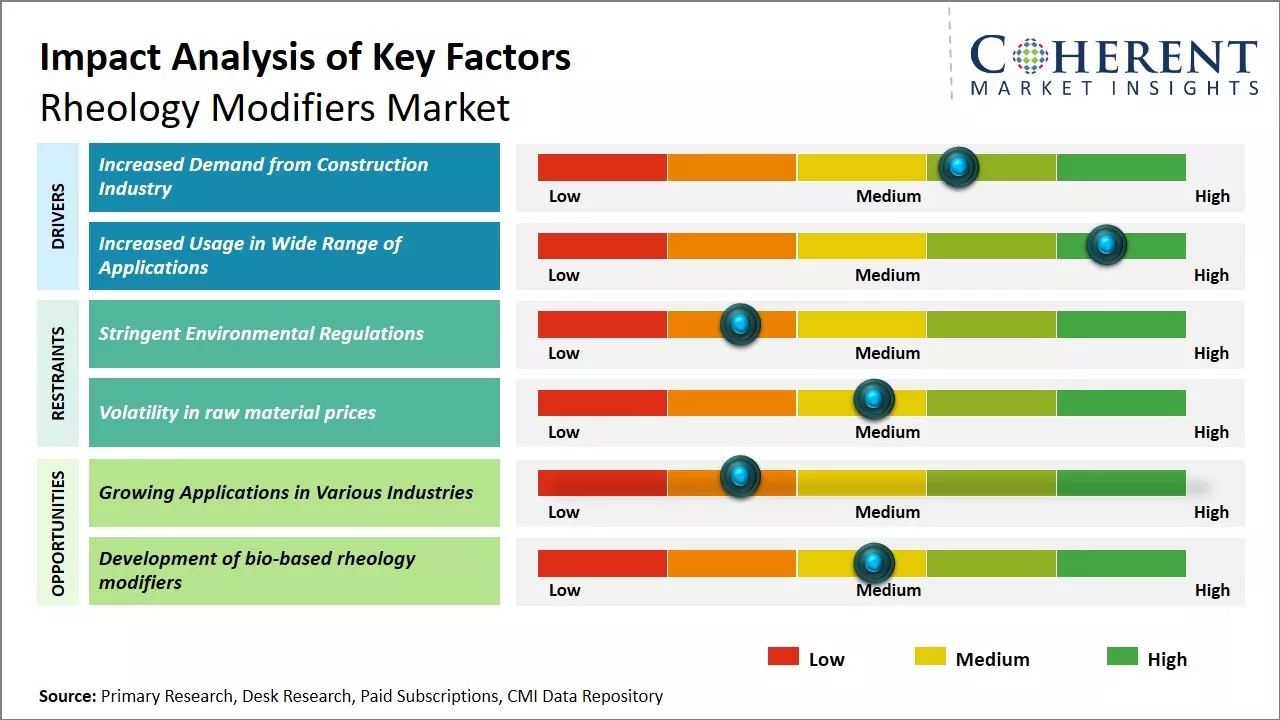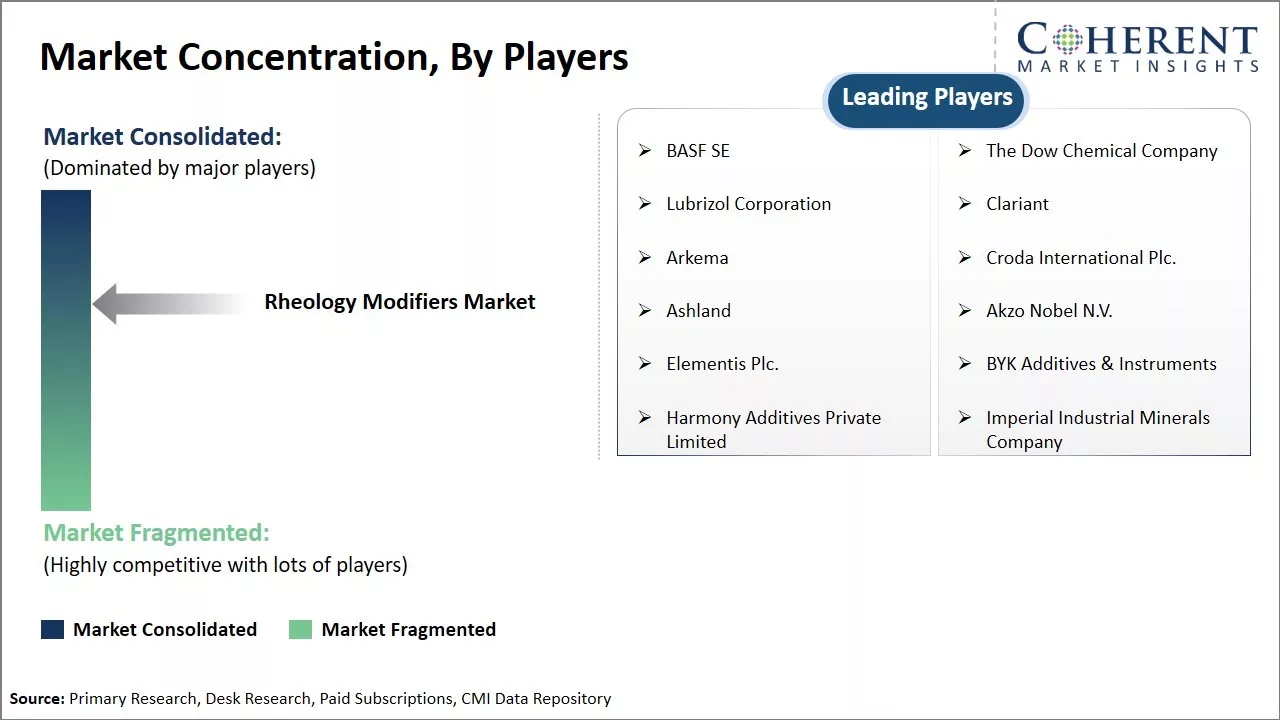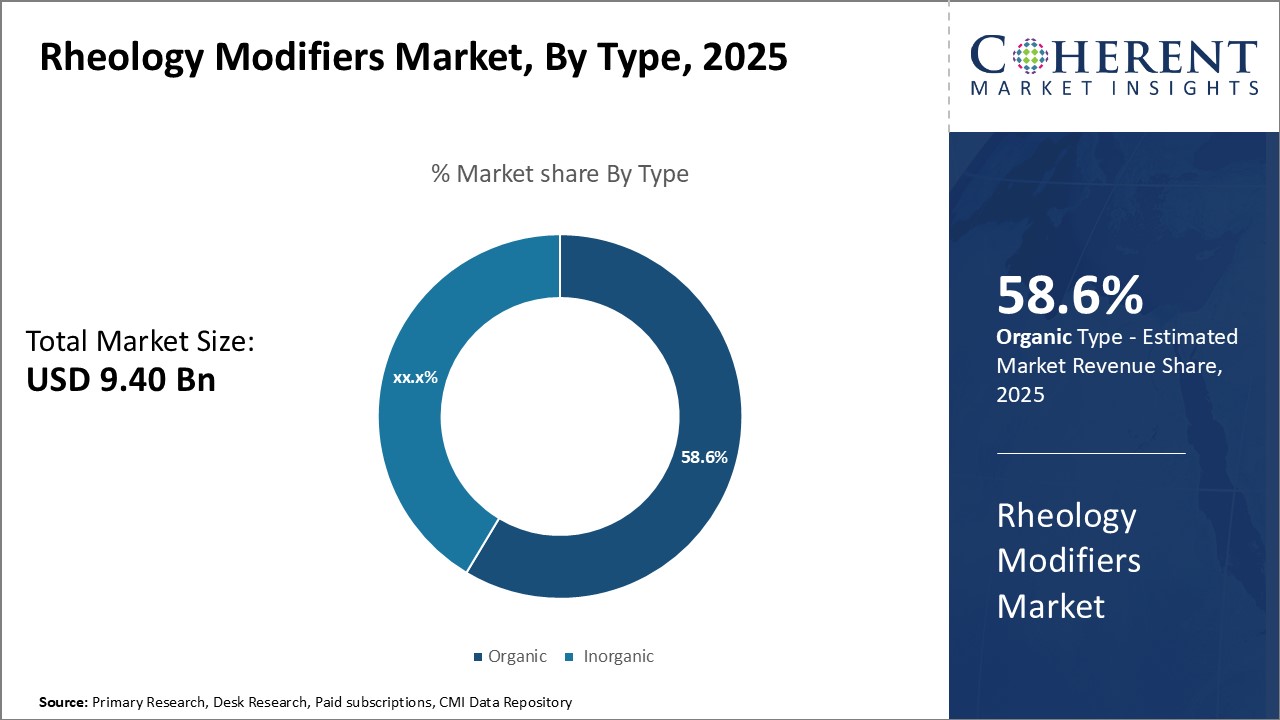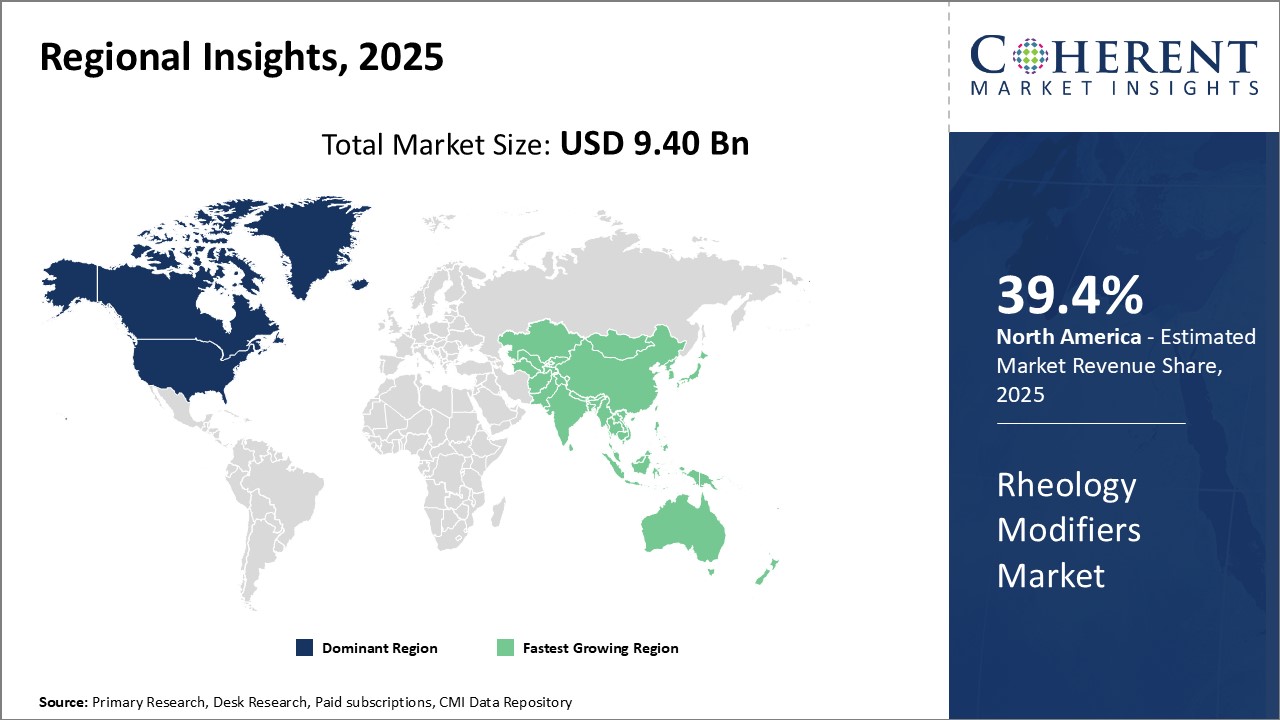The Rheology Modifiers Market is estimated to be valued at USD 9.40 Bn in 2025 and is expected to reach USD 12.79 Bn by 2032, exhibiting a compound annual growth rate (CAGR) of 4.5% from 2025 to 2032.

Discover market dynamics shaping the industry: Request sample copy
The demand for rheology modifiers is expected to grow during the forecast period. The growth of the paints and coatings industry supported by infrastructure development projects in emerging nations along with growing demand for personal care and cosmetics will drive the market growth. Furthermore, the increasing need for cost-effective viscosity control additives with performance advantages over traditional modifiers is expected to support the market growth. New product launches and expansion strategies by key players to cater to the growing demand from applications such as construction, personal care, and oil and gas industry will further aid the market growth during the analyzed time period. However, strict environmental regulations regarding the use of certain chemistries may negatively impact the growth of the rheology modifiers market.
Increased Demand from Construction Industry
The global construction industry has seen steady growth over the past few years and this growth is expected to continue going forward. Mega infrastructure projects, investments in public infrastructure by various governments, and increasing number of new construction activities are fueling the demand. The construction industry widely uses materials like concrete, mortar, grouts etc. which require effective rheology modifiers to impart desired flow properties and strength. As constructions activities increase across major regions, the demand for concrete admixtures and additives also rises. This positively impacts the rheology modifiers market. Rheology modifiers are essential in producing quality concrete that can easily be mixed, transported, poured and consolidated without segregation of its ingredients. They are added to concrete mixtures in small proportion but play a very important role in achieving specified workability and strength. With ongoing and upcoming construction of dams, roads, bridges, commercial buildings, housing complexes etc. the need for large volume of concrete becomes higher. Constructors prefer concrete mixes incorporating rheology modifiers to get improved performance and handle large volume requirement efficiently. Further, sustainability regulations in construction industry also drive the use of specific rheology modifiers which can reduce water content in concrete without compromising workability and deliver environmental benefits.

Get actionable strategies to beat competition: Request sample copy
Increased Usage in Wide Range of ApplicationsRheology modifiers have found diverse applications beyond traditional construction materials like concrete and cement. Significant usage is observed in paints & coatings, personal care products, pet food, mineral processing, pharmaceuticals, and many other industrial sectors. This expanded application landscape offers broader growth opportunities for players in rheology modifiers market. For instance, rheology modifiers are gaining importance in formulating various pharmaceutical products like gels, emulsions, and suspensions.

To learn more about this report, Request sample copy
Market Challenges: Stringent Environmental RegulationsThe rheology modifiers market faces challenges from stringent environmental regulations globally. The use of certain rheology modifiers contains chemicals that are considered hazardous to the environment. Stricter rules have limited the application of such additives. Additionally, volatile raw material prices pose a major threat. Many key feedstocks used in producing rheology modifiers are crude oil based and see frequent price fluctuations. This adds an element of unpredictability to costs.
Market Opportunities: Growing Applications in Various Industries
There is increasing demand from the food and beverage sector for rheology modifiers that help optimize texture and shelf-life. Rapid infrastructure development worldwide is propelling the paints and coatings industry, driving consumption. Furthermore, the use of bio-based rheology modifiers presents green options for manufacturers seeking sustainable solutions.

Discover high revenue pocket segments and roadmap to it: Request sample copy
Insights, By Type: In terms of Type, Organic contributes the highest share of the market owing to its wide applicability and compatibilityThe organic segment accounts for the 58.6% share in the rheology modifiers market due to its advantages over inorganic modifiers. Organic rheology modifiers are derived from various natural sources like plant extracts, polysaccharides, proteins and synthetic polymers. They are compatible with a wide range of formulations and find usage in several end-use industries. Organic rheology modifiers exhibit superior thickening, suspension and stabilization properties. They offer formulation flexibility and help achieve the desired viscosity and flow behavior. The organic nature makes them safer and more environment-friendly compared to inorganic variants. They are less abrasive and cause minimal damage to processing or packaging equipment over long-term usage. The personal care and cosmetics industry has emerged as a major consumer of organic rheology modifiers. New product innovations and demand for natural and clean-label ingredients are driving increased adoption. Organic rheology modifiers are able to provide texture and stability to a diverse range of personal care products ranging from creams, lotions and gels to hair stylings. In the paints and coatings sector, organic rheology modifiers enhance the flow, leveling and brushability of various formulations. This enables uniform coatings of different thicknesses and gloss levels to be applied. Their use helps optimize the rheological properties to suit specific paint types and ensures efficient and drip-free application. The wide compatibility and versatility of organic rheology modifiers has made them prevalent across homecare, food, pharmaceuticals and other process industries. Superior functionality, formulation tolerance, and clean label appeal are compelling reasons for their widespread use over inorganic alternatives.
Insights, by Application: In terms of Application, Household Products contribute the highest share owing to evolving product categories
The household products segment holds the 41.7% share in the overall rheology modifiers market owing to constant innovations expanding its scope. Rheology modifiers are integral ingredients used for manufacturing an assortment of cleaners, detergents and personal hygiene products consumed daily in households. Consumers today expect multipurpose cleaners and laundry detergents that work effectively on different surfaces and stains in one wash. Rheology modifiers play a key role in developing innovative product formulations with optimized rheological behavior. They enable achieving ideal viscosity and dilution properties for achieving superior cleaning and stain removal results. Personal wash categories like shampoos, shower gels and liquid hand wash have also grown in popularity over bar soaps. Manufacturers rely on rheology modifiers to impart a rich texture and luxurious feel to personal wash products. They make emulsions and gels stable yet spreadable for a pleasurable experiences. In domestic markets across regions, the shelf space dedicated to packaged household goods is steadily rising. Product diversification has led to a boom in specialized fabric conditioners, dish wash gels, surface cleaners and air fresheners. As new product types emerge, the formulation requirements also change, further propelling the use of rheology modifiers in the household products segment.

Need a Different Region or Segment? Customize now
North America has established itself as the dominant regional market for rheology modifiers with 39.4% share. The region accounts for the largest share of global demand owing to the well-established personal care, paints & coatings, and construction industries in countries like the U.S. and Canada. Strong presence of leading formulation companies and raw material producers in the region provides easy access to rheology modifiers. Stringent regulations regarding product quality and consistency across various application areas further cements North America's top position. Leading customized solutions by local players help end-use industries achieve desired rheological properties. Export of rheology modifiers from North America also contributes to its high consumption. The technical expertise of regional market participants further aids new product development.
Asia Pacific has emerged as the fastest growing regional market for rheology modifiers in recent years. Rapid infrastructure development and industrialization across developing countries like China and India are driving growth. Expanding middle class population with rising disposable incomes is propelling the personal care and homecare sectors. This acts as a major trigger for rheology modifiers demand. China, in particular, exhibits immense future potential attributed to supportive government policies and initiatives to boost domestic manufacturing. Increasing foreign investments in key industries such as paints & coatings and construction are also assisting the APAC market. In addition, the presence of cost-competitive raw material suppliers provides APAC formulation companies an edge over import-reliant regions. The growth is further accelerated by improving R&D capabilities of regional players to innovate customized formulations as per end-use requirements. The rising exports from APAC, especially to developed countries, cements its position as the new global growth epicenter. However, environmental regulations are relatively less stringent in the region, thereby enabling easier market penetration of existing as well as new entrants.
Rheology Modifiers Market Report Coverage
| Report Coverage | Details | ||
|---|---|---|---|
| Base Year: | 2024 | Market Size in 2025: | USD 9.40 Bn |
| Historical Data for: | 2020 To 2024 | Forecast Period: | 2025 To 2032 |
| Forecast Period 2025 to 2032 CAGR: | 4.5% | 2032 Value Projection: | USD 12.79 Bn |
| Geographies covered: |
|
||
| Segments covered: |
|
||
| Companies covered: |
BASF SE, The Dow Chemical Company, Lubrizol Corporation, Clariant, Arkema, Croda International Plc., Ashland, Akzo Nobel N.V., Elementis Plc., BYK Additives & Instruments, Harmony Additives Private Limited, and Imperial Industrial Minerals Company |
||
| Growth Drivers: |
|
||
| Restraints & Challenges: |
|
||
Uncover macros and micros vetted on 75+ parameters: Get instant access to report
*Definition: The rheology modifiers market involves chemicals and materials that are used to alter the flow properties and viscosity of various industrial materials and formulations. These modifiers are added to products like paints, coatings, inks, adhesives, pharmaceuticals, personal care items, and food & beverages to control their rheology and improve performance, quality, and manufacturing processes.
Share
Share
About Author
Yash Doshi is a Senior Management Consultant. He has 12+ years of experience in conducting research and handling consulting projects across verticals in APAC, EMEA, and the Americas.
He brings strong acumen in helping chemical companies navigate complex challenges and identify growth opportunities. He has deep expertise across the chemicals value chain, including commodity, specialty and fine chemicals, plastics and polymers, and petrochemicals. Yash is a sought-after speaker at industry conferences and contributes to various publications on topics related commodity, specialty and fine chemicals, plastics and polymers, and petrochemicals.
Missing comfort of reading report in your local language? Find your preferred language :
Transform your Strategy with Exclusive Trending Reports :
Frequently Asked Questions
Joining thousands of companies around the world committed to making the Excellent Business Solutions.
View All Our Clients
US Reciprocal Tax Impact Analysis On Rheology Modifiers Market
Stay updated on tariff changes with expert insights and timely information